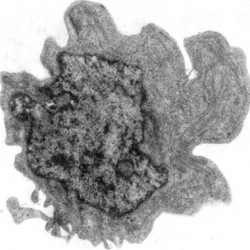 Using waste proteins to choke multiple myeloma cells
Using waste proteins to choke multiple myeloma cells
Expanding piles of rubbish are rarely cause for celebration. Just as bin-bags piled on street corners pose problems, accumulation of waste molecules within cells can wreak havoc on their functioning. But for Dr Holger Auner, who has been carrying out research at the CSC for the last 6 years, the build-up of waste proteins in cells lies at the heart of an attempt to find a new therapeutic avenue for cancer. A new grant from Cancer Research UK will allow him to build on recent research in the Gene Regulation and Chromatin Group to investigate how interfering with pathways of protein degradation in cells might be used to battle multiple myeloma – a form of bone marrow cancer derived from plasma cells.
Plasma cells are specialised immune cells that produce antibodies. They typically exist in one of two forms: as long-lived cells involved in long-term immunity, or short-lived cells produced during an acute infection. During their fleeting existence, short-lived plasma cells produce huge numbers of antibodies. This mass-production requires rapid protein folding within the endoplasmic reticulum (ER) – a complex process susceptible to error. Any misfolded proteins must be exported from the ER and degraded, to prevent them clogging up the cell. During his PhD, Auner suggested that the life spans of these plasma cells are in part limited by “secretory stress” – when the levels of misshapen protein get too high, the cell can no longer cope.
“These plasma cells secrete up to 10,000 molecules per second,” says Holger. “No other cell in the body does that. But it gives the cell too much protein waste. The cell tries to expand the garbage collection facility, but at some point it gets too much, and the cell can’t cope.”
Dr Auner is hoping to apply this to the cancer cells. “Myeloma cells also secrete proteins,” he explains. “I want to try to block the protein clearance pathways.” Drugs already exist that target the proteasome – the unit in the cell that handles the majority of waste protein. Holger is targeting the process a step earlier: “I am interested in a protein that pulls misfolded proteins from the endoplasmic reticulum. It’s a step before the proteasome, and to block that could mean more effective treatment, more specific to myeloma cells.”
The protein in question is called p97. Preliminary work done at the CSC has already revealed that simultaneously blocking this protein and the proteasome has a major effect on myeloma cells, but is relatively harmless to many other normal body cells. Using a Cancer Research UK Clinician Scientist Fellowship and £759,000 grant, Holger plans to take the work forward at Imperial College London. “That work is now the basis for a more systematic investigation into how the pathways work. We know that blocking them has a toxic effect, but there are lots more questions: what signal cascades are triggered? What is the difference between different cell types? Are there any side effects? We’re taking a step back, and starting a very methodical investigation.”
-AL
